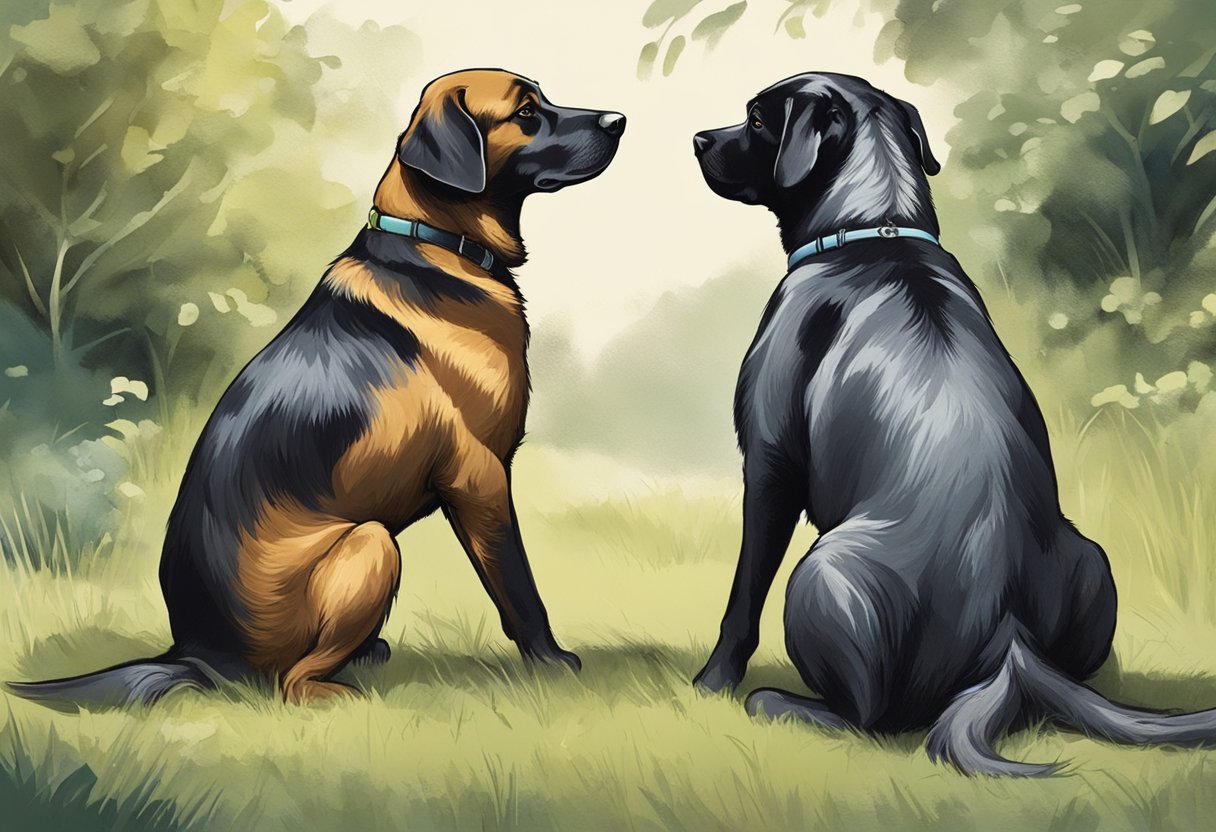When observing canine interactions, a common sight is one dog presenting its rear to another dog. This behavior may initially appear odd to humans, but in the world of dogs, it carries significant communicative weight. The bum presentation is a form of social behavior rooted deeply in canine communication. Dogs have scent glands located near their tails, which release a unique set of information to other dogs. By presenting their rear, they’re essentially sharing a ‘business card’ full of personal data such as health, emotional state, and even intentions.

Understanding what a dog is trying to convey by this action requires a bit of insight into canine behavioral cues. It’s not always a straightforward message; context plays a crucial role in interpretation. This bum pushing could be exhibiting playfulness, appeasement, or even nervousness, depending on the situation and the dogs involved. Watching other body language signs and observing the reaction from the bum recipient can provide additional insights into this multifaceted mode of communication.
Key Takeaways
- Dogs use their bum presentation to communicate information via scent.
- The behavior’s meaning is context-dependent and can indicate play, submission, or other intentions.
- Observing accompanying body language and reactions from other dogs helps interpret this behavior.
Canine Communication and Social Behavior

In the complex world of dogs, body language and scent play pivotal roles in social interactions. These natural behaviors allow dogs to communicate effectively and establish their place within social hierarchies.
Understanding Dog Communication
Canine communication encompasses a range of behaviors, with body language being a fundamental aspect. Dogs convey messages to each other using posture, tail position, facial expressions, and movements. For instance, a dog presenting its rear to another can signal various intentions or feelings. This action may seem odd to humans, but in canine parlance, it’s a gesture that can indicate trust, an invitation to play, or a method of gathering information.
The Role of Scent in Socialization
Scent is an equally crucial element in dog socialization. Dogs have anal scent glands that produce unique pheromones, providing a wealth of information about them, such as their identity and emotional state. By engaging in scent marking, they communicate their presence and territory to other dogs. Smell facilitates a critical part of canine interaction, enabling dogs to learn about each other’s health, diet, and reproductive status without any physical contact.
Interpretations of the Bum Presentation

When dogs present their bums to another dog, it can signal various social cues, ranging from affection to power dynamics. Interpreting this body language depends on the context of the interaction and the subsequent behavior of both dogs.
Affection and Trust Signal
A dog turning its back to another and presenting its bum can indicate a signal of affection and trust. This submissive gesture showcases that the dog feels comfortable and does not deem the other dog a threat. By exposing a vulnerable part of their body, the dog communicates trust and an expectation of safety from the receiving canine.
Asserting Dominance
Conversely, in some contexts, the bum presentation may be a sign of dominance. If the behavior is accompanied by a stiff posture or a high tail, it can imply an attempt to assert dominance. While it might seem contradictory, some dogs exhibit their dominance by displaying confidence in allowing others close to their rear without concern for attack.
Invitation to Play
Often, when a dog presents its bum, it’s an invitation to play. This can be seen with the play bow, a stance where the dog lowers its front body with its rear end up, which is widely recognized as a playful gesture. When associated with the bum presentation, it can indicate playfulness and an eager anticipation for a friendly romp.
Behavioral Context

In understanding why dogs put their bums towards other dogs, it is essential to recognize the role of pheromones and physical contact within their social interactions. These behaviors contribute to their complex communication system and bonding processes.
Pheromone Exchange and Information Gathering
Dogs communicate extensively through pheromones, which are chemicals that convey detailed information about their health, emotional state, and readiness to mate. The anal glands of dogs secrete pheromones that are unique to each individual. When a dog presents its bum to another dog, this act allows for a pheromone exchange. By sniffing another dog’s scent, they gather crucial information about their new acquaintance. This pheromone exchange is a key part of canine communication and socialization, providing context and helping them understand their environment and other dogs within it.
Physical Contact and Bonding
Physical contact, such as the hip nudge or nudging, further solidifies social bonds between dogs. This behavior also involves a display of trust and comfort as dogs are allowing another to be close to a vulnerable area. Bonding occurs through these interactions, establishing social hierarchies and friendships among dogs. The act of putting their bum towards a peer can seem like a singular action, but in reality, it encompasses a series of communicative and bonding cues imperative to canine interaction. Physical actions, such as the bum display or hip nudge, often complement the scent exchange to create a multi-sensory greeting or play gesture, deepening the physical and emotional context of their environment.
Interpreting Subtle Dog Behaviors
When observing dogs, it’s crucial to comprehend the nuances of their body language, which often convey their emotional state and intentions.
Reading Submissive and Playful Gestures
Submissive gestures in canines are vital cues indicating a dog’s desire to avoid conflict and show politeness. Canine behavior experts suggest that when a dog pushes its bum towards another dog, it’s often an appeasement signal, demonstrating submissiveness or friendliness. This action is typically accompanied by other submissive body postures, such as lowered ears and avoidance of direct eye contact.
Playfulness is another aspect of canine communication, easily misinterpreted without an understanding of subtleties. The display of a dog’s rump, paired with other signals such as a wagging tail and an energetic stance, can denote an invitation to engage in play. This interpretation is strengthened when the head is lowered and the bum is raised, an iconic playful behavior known as the play bow.
Recognizing Signs of Anxiety and Discomfort
While subtle cues of play and submission are common, dogs also express anxiety and discomfort through their body language. A dog presenting its backside might be displaying awareness of its surroundings by positioning itself defensively. The tension in the body, pulled-back ears, and a tucked tail are signs that the dog is experiencing discomfort or anxiety.
Understanding these subtle cues requires careful attention to the full spectrum of a dog’s body language. For instance, a stiff body posture along with a turned rear may suggest the dog feels threatened, whereas a relaxed body and a casually wagging tail typically signify ease and comfort.
Seeking Professional Insight
In some cases, a dog’s behavior, such as presenting their bum to another dog, may require the assessment of a certified professional. This provides clarity and potential solutions when a behavior seems puzzly or problematic.
When to Consult a Behaviorist
Owners should consider seeking professional guidance when their dog’s behavior consistently deviates from the norm or when it leads to discomfort for the dog or others. Situations that merit consultation with a behaviorist include but are not limited to aggressive responses during bum-presenting interactions, extreme submissiveness, or if a dog is seemingly unable to engage in normal play behavior.
- Aggression or fearfulness: If the behavior triggers aggression from other dogs, or if the dog seems fearful when attempting to interact in this manner.
- Lack of social cues understanding: When a dog continually misreads or ignores other dogs’ social signals, potentially causing conflict.
- Change in behavior: A sudden shift in how a dog behaves around other dogs, especially if it is an older dog that previously had well-established patterns of behavior.
Contacting a professional dog behaviorist or a dog trainer with experience in dog behavior can help correct these issues. They will typically:
- Observe the dog in its natural environment.
- Identify triggers and underlying causes of the behavior.
- Develop a personalized training plan.
Consulting a behaviorist can reveal if the bum-presenting is a sign of a dog trying to communicate or if there might be an underlying health issue influencing the behavior. Professional help is invaluable in determining the best course of action for each individual dog and their circumstances.
Gender-Specific Behaviors
In observing canine behavior, distinct patterns emerge in correlation with gender, particularly when examining the actions of female dogs. These behaviors can be tied to various factors including their reproductive cycle and mating behavior.
Understanding Female Dog Behavior
Female dogs exhibit specific behaviors that are often misunderstood. For instance, when a female dog presents her rear to another dog, it could be an expression of dominance, as dogs have hierarchical social structures. This posture can serve as a communication tool, conveying status or control within a group.
Moreover, the behavior can be related to the female’s reproductive cycle. During certain phases, female dogs might be more prone to display their rear as a part of mating behavior, signaling their availability to males. It is a non-verbal cue that can incite or discourage interaction, depending on the female’s receptivity or the social context.
Behavioral nuances can be subtle and vary among individual dogs, so it is essential to consider the dog’s overall body language and the dynamics of the specific interaction to fully understand the intention behind the action.
Frequently Asked Questions
This section answers common inquiries about canine behavior related to dogs presenting their rear to each other. Understanding these behaviors can offer insight into a dog’s social interactions.
What does it mean when a dog presents its rear to another dog?
When a dog presents its rear to another dog, it is typically a sign of trust and a gesture of friendliness. The rear end carries a dog’s unique scent, which can convey information about its identity and mood to other dogs.
Is it normal for a dog to sit on the face of another dog?
Although it may seem unusual, a dog sitting on the face of another dog can be a normal behavior. This act can establish dominance or be part of a playful interaction, depending on the context of the behavior.
What is the behavior behind a dog nudging another dog with its hip?
A dog nudging another dog with its hip is a form of communication and can be an invitation to play. This gentle push with the hip is referred to as “hip nudging,” and it can also serve as a test of the receiving dog’s reaction and social boundaries.
Can you explain why dogs might turn their backs to one another?
Dogs might turn their backs to one another as a form of non-confrontational behavior. It demonstrates that they are not a threat, allowing them to communicate calmly without direct eye contact, which can be perceived as aggression.
What is the significance of a dog lifting its leg for others to smell?
A dog lifting its leg for others to smell is offering access to its scent glands, located near the tail. This action is another form of social communication, where the dog is sharing its unique scent and gathering olfactory information about the other dog.
How should one interpret a dog’s bum in the air pose, often seen during play?
The “bum in the air” pose, often paired with front paws stretched forward, is known as the “play bow.” This stance is a clear signal that the dog is in a playful mood and is commonly seen during playtime, inviting others to join in the fun.
